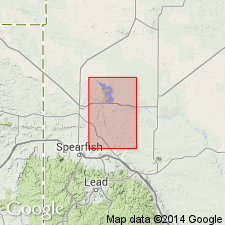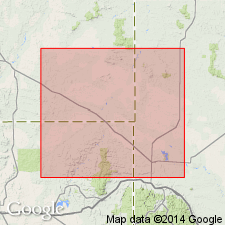
- Usage in publication:
-
- Orman Lake limestone
- Modifications:
-
- Named
- Dominant lithology:
-
- Limestone
- Shale
- Coquina
- AAPG geologic province:
-
- Williston basin
Summary:
Is named as an unranked Upper Cretaceous unit near the middle of the "Bell Fourche shale member" of the "Graneros formation". Is named from the "very good exposures" on the west and south sides of Orman Lake and in the peninsula that extends into the lake from the southeast in southwest Butte Co, SD (Williston basin). Stratotype not designated, but a measured section is given north of Haystack Buttes in sec 10, T8N, R3E. Replaces preoccupied name "Middle Creek limestone" of Wing (1940), which is herein abandoned. Is mapped (plane table survey, 1 in to 2500 ft) in southwest Butte and northeast Lawrence Cos, SD. "The Orman Lake limestone is a beach coquina. The material is composed entirely of broken shells reduced to all sizes. It contains also black grains and flakes of organic material and emits a strong petroleum odor when struck with a hammer. A distinguishing characteristic of the limestone is its abundance of shark teeth. The rock is gray-brown when fresh and light buff to yellow when weathered. It is hard and resistant enough to be a ledge-maker. At the outcrop it breaks out in large slabs which are generally used for riprapping stock dams. The limestone occurs in at least three layers." Unit is about 21 ft thick in Haystack Buttes section and comprised of slabby coquina limestone, gray calcareous shale, and gray-blue bentonite.
Source: GNU records (USGS DDS-6; Denver GNULEX).

- Usage in publication:
-
- Orman Lake Limestone Member*
- Modifications:
-
- Biostratigraphic dating
- Overview
- AAPG geologic province:
-
- Williston basin
- Powder River basin
Summary:
Is basal member of the Upper Cretaceous (upper Cenomanian and lower Turonian) Greenhorn Formation on the northern flank of the Black Hills uplift in southwest Butte Co, SD and southeast Carter Co, MT (Williston basin) and northeast Crook Co, WY (Powder River basin). Described as a limonitic calcarenite bed about 0.3 m thick that forms the base of the Greenhorn and rests disconformably on the Belle Fourche Shale (Cenomanian). The calcarenite bed was previously described by Rubey (1930, p. 6,7), was named the "Middle Creek limestone ledge" of the Graneros by Wing (1940, p. 6), and was renamed the "Orman Lake limestone" by Petsch (1949, p. 9), and was also referred to as the "Bull Creek sandy limestone" after Bramlette and Rubey in Moore (1949, p. 27). The bed contains numerous fragments of bivalves and ammonites. Cobban (1951, p. 2184) listed the ammonite fauna and the present report updates the faunal list as: DUNVEGANOCERAS PONDI, CALYCOCERAS (PROEUCALYCOCERAS) CANITAURINUM, and METOICOCERAS PRAECOX. This fauna places the unit in the lowermost upper Cenomanian ammonite zone of DUNVEGANOCERAS PONDI.
Source: GNU records (USGS DDS-6; Denver GNULEX).
For more information, please contact Nancy Stamm, Geologic Names Committee Secretary.
Asterisk (*) indicates published by U.S. Geological Survey authors.
"No current usage" (†) implies that a name has been abandoned or has fallen into disuse. Former usage and, if known, replacement name given in parentheses ( ).
Slash (/) indicates name conflicts with nomenclatural guidelines (CSN, 1933; ACSN, 1961, 1970; NACSN, 1983, 2005, 2021). May be explained within brackets ([ ]).

